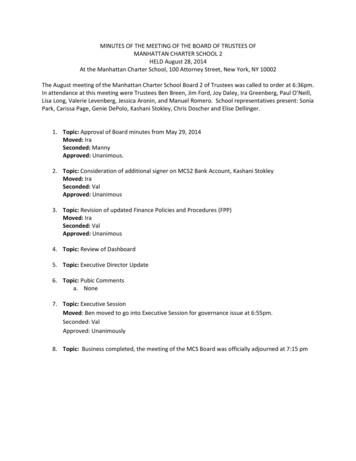
Transcription
“I am crazy for the luster ofmy beloved who is differentI am amazed by his beautifulform which is different.The rest are involved in caresand woes which are different,My fears and grief are aboutsomething that is different.”Image: Walters Art MuseumSarmad KashaniSarmad Kashani (Sarmad of Kashan; also known as Muhammad Sa’id Sarmad)was a Persian Jewish poet and mystic. He was born into a well-to-do family ofmerchants and scholars in Kashan (Iran) around 1590. In the 1630s, his tradebrought him to the port city of Thatta in present-day Pakistan. There he fellin love with a young Hindu man named Abhai Chand. This love was a mysticalrevelation, inspiring him to devote his life to the pursuit of spiritual unity.Together Abhai and Sarmad travelled across the Indian subcontinent, eventuallyreaching Delhi, where they were welcomed at the Mughal court of Dara Shikoh.Sarmad wrote hundreds of mystical rubaiyat poems there, and he and Abhaitogether translated the Torah into Persian. Like other mystical poetic traditions,Sarmad’s rubaiyat use the metaphor of earthly love to describe longing for theDivine. Sarmad was executed by Dara Shikoh’s brother, the emperor Aurangzeb,for heresy in 1660. His grave in Delhi is still a sacred site for pilgrims of all faithsto this day.DAY ONE / Chesed / Lovingkindnesskeshetonline.org/guests
“You were handed overto the glaring lightto the threatening loveforce of the island sunyou, almost with toomuch wisdom to live.Gods, however, desiredthat you sing.”Vera LachmannVera Lachmann (1904–1985) was a German-American Jewish classicist, poet,and teacher. She studied Germanic languages and Greek philosophy at theUniversity of Berlin. In 1933, as the German government began to imposerestrictions on Jewish students, she opened a school in Berlin for Jewishchildren, maintaining it until it was forcibly closed in 1939. Lachmann managedto flee Germany for the US shortly afterwards, and taught Classics at severalAmerican universities until her retirement. She also founded an educationalsummer camp, Camp Catawba, which she directed for decades alongside herlifelong partner, visionary American composer Tui St. George Tucker (1924–2004). In 1969, Lachmann dedicated her first volume of poetry, Golden Tanztdas Licht im Glas (Golden Dances the Light in the Glass), to her. In these poems,Lachmann recalls their 1967 pilgrimage to the island of Lesbos, the birthplaceof Sappho, who first put into words the power of love between women.DAY ONE / Chesed / Lovingkindnesskeshetonline.org/guests
“People must realize that theyare as they are, and whetheror not they have engaged inconduct proscribed by thelaw at the time of arrest, theystill have rights guaranteed byfederal and state laws.”Pearl HartImage: Gerber/Hart ArchivesPearl M. Hart (1890–1975) was a pioneering American Jewish attorney, activist,and educator. Born to Russian immigrants, she was one of the first femaleattorneys to specialize in criminal law. Hart devoted her life to defending thelegal rights of the vulnerable and oppressed, especially women, children,immigrants, and gay men and lesbians. In addition to her legal work, Hart taughtat John Marshall Law School and at the Northwestern University School ofSocial Work. She also participated actively in local and national progressivepolitics. Throughout it all, she maintained a humble focus on defending civilliberties for all. Although she never publicly identified as a lesbian, she was oneof the founding members of the Chicago Mattachine Society, one of the firstLGBTQ organizations in the United States. Serving as a “professional advisor,”she offered free legal advice to gay men and lesbians worried about arrest andharassment, represented them in court, and passed along information aboutplanned police raids. Her reputation as an unflinching defender of civil rightsgave her the nickname “The Guardian Angel of Chicago’s Gay Community.”DAY TWO / Gevura / Judgementkeshetonline.org/guests
“Homosexuality, per se, is neither asickness, a defect, a disturbance, aneurosis, a psychosis, nor a malfunctionof any sort Not only is homosexuality,whether by mere inclination or by overtact, not immoral, but that homosexualacts engaged in by consenting adultsare moral, in a positive and real sense,and are right, good and desirable, bothfor the individual participants and forthe society in which they live.”Frank KamenyImage: New York Public Library ArchivesFranklin Kameny (1925–2011) was a pioneering American Jewish gay rightsactivist, who coined the slogan “Gay is Good” and was one of the leaders inspurring the homophile movement into political activism. Born in New York City,Kameny served in the Army in the Second World War, and graduated from Harvardwith a doctorate in astronomy in 1956. Shortly afterwards, he became one of thehundreds of Americans who lost employment during the “Lavender Scare” of the1950s, part of the larger social panic of McCarthyism around communism. Kamenyprotested his unjust termination in the courts, eventually reaching the SupremeCourt in 1961. His was the first civil rights claim based on sexual orientation beforethe Supreme Court. When his case was denied, he realized that what he called “thehomophile movement” needed to advocate more vocally for its rights. Kameny cofounded the Mattachine Society of Washington that year, lobbied the AmericanPsychological Association to remove the classification of ‘homosexuality’ as amental disorder, and was active in LGBTQ activism until his death. Throughout hislife, he argued that activists should focus on eliminating social prejudice and legaldiscrimination, insisting that just like race, religion, or other aspects of identity,queerness needs to be respected, not cured or treated.DAY TWO / Gevura / Judgementkeshetonline.org/guests
“We called upon the said EstherBrandeau to state for whatreason she had so concealed hersex over the course of these fiveyears. [They stated that theyhad] resolved not to return anymore to her father and mother,in order that she might enjoy thesame liberty as the Christians.”Image: Library and Archives CanadaEsther/Jacques BrandeauEsther/Jacques Brandeau (ca. 1718–1744?) was a Sephardi traveller whocrossed multiple boundaries of gender, religion, nationality, and identity. Bornin southwestern France to a branch of the Dutch Sephardi Brandon family,Esther/Jacques ran away from home, took on the identity of a young mannamed Jacques, and spent several years in various French cities and on ships,eventually reaching the French colony of Québec on the land of the native HuronWendat Nation. There, in 1738, Brandeau was doubly “outed” as both a womanand a Jew. At the time, French law prohibited any non-Catholics from settling inits colonies. Brandeau is the first known Jewish person to have entered what isnow Canada. Refusing to convert to Christianity, they were sent back to France,where they disappeared from the archival record.DAY THREE / Tiferet / Beautykeshetonline.org/guests
“Being in this city [of Bahia] and confessing,this Jew said that in Turkey, [starting whenhe] was about 18 years old, he committedthe nefarious sin of sodomy [many times] Then he was in Venice for ten or twelve years,spending the nights in his bed with a youngman And he confessed further that for thelast five years, more or less, while he hasbeen in this city, [a young man] came to hishouse, and both laid down in the bed of theconfessant [and] completed the mentionednefarious sin.”João BatistaImage: Library of Congress, Geography and Map DivisionJoão Batista (b. 1560) was a Portuguese Jewish merchant, born to Sephardiconversos (Jews forced to convert to Christianity) who had fled to the OttomanEmpire. In 1593, while living in Brazil, he was called before the Inspector ofthe Holy Office of the Portuguese Inquisition, to answer charges of “Judaizing,”returning to Jewish practice, and “sodomy,” an antiquated term and Christianlegal notion of sexual “crimes,” referring in this case to sexual activity betweenmen. Batista confessed to his many Jewish and non-Jewish lovers, including notonly his current partner in Brazil, but also in Italy, the Ottoman Empire, Portugal,and the African island of São Tomé. His life story mirrors the stories of Iberianconversos who established interconnected diaspora communities throughoutWestern Europe, the Ottoman Empire, and the Americas. Batista was fortunateto receive a pardon, and promised that “from today forward he would not dosuch horrible and nefarious sins.”DAY THREE / Tiferet / Beautykeshetonline.org/guests
“On January 12, I paid the executionerAlfonso for cord and gloves which servedto burn Issach Salamó of Calatayud, a Jew,who was convicted of the sin of sodomy.On the same day, following the orderof the bailiff, I paid Joffrena de Gariusfor renting out her horse, which carriedIssach to the place where he was burned.I paid Pere de Castres, vice-bailiff, forone somada of olive tree wood, which hepurchased for [the purpose of burning]the said Issach.”Issach Salamó:Issach Salamó (d. 1403) was a Spanish Jew who was tried and condemned forhaving sexual contact with another man in Perpignan in the winter of 1402.Originally from the Aragonese town of Calatayud, Salamó was living in the smalltown of Tuïr (Thuir) near Perpignan, in what was then the Catalan provinceof Rosselló (now Roussillon, France). In 1402, he was arrested and tried forsodomia — a legal notion formulated by Christian scholars in the mid-eleventhcentury as a sexual “crime against nature.” Punishments included beatings,confiscation of property, exile, castration, and death. In many Christian legalcodes, sex between men was also closely connected to religious heresy and toimproper relationships between Christians and Jews or Muslims, and Jews werefrequently persecuted for perceived or real gender and sexual diversity. Salamówas burnt at the stake on the twelfth of January, 1403; according to this notarialrecord, the total expense of his execution came to 38 sous and 4 diners.DAY FOUR / Netzach / Eternitykeshetonline.org/guests
“I admit to having written a book entitledLesbian Love, based on true facts and livingcharacters of today I believe the book is notin any way immoral, indecent, or vulgar It wasonly meant to show the humorous side of life,the serious side of life, and tragedy, all in one Had I known that by telling the truth of these socalled unfortunate people whom God chose tocreate different and willed them to be so, had Iknown I am committing a crime against a law andagainst this country which I love with my heartand soul Had I known it was a crime, I wouldnot have told the truth.”Eve AdamsImage: Ben Reitman Papers, University of Illinois at ChicagoEve Adams (1891-1943) was a Polish-American Jewish writer and lesbianactivist. Born Khave Zloczower in Poland, she immigrated to the United Statesin 1912, where she sold leftist and anarchist magazines, and ran a series oftearooms in Chicago and New York City which served as community hubs for gaymen and lesbians. In 1925, Adams published a remarkable collection of shortstories, based on the women she had known and loved, boldly entitled LesbianLove. Printed privately in 150 copies, it describes in gentle and compassionateterms the vibrant and sometimes turbulent relationships between women. It isbelieved that this book is the first study of the lesbian community in the UnitedStates written by a lesbian author. In 1926, Adams’ tearoom was raided after shegave an autographed copy of Lesbian Love to an undercover policewoman. Shewas arrested and charged with “publishing obscene literature” and “disorderlyconduct.” She was deported from the United States to Poland the following year,and settled in France. In 1943, she and her partner were arrested by Nazi agentsand sent to Auschwitz, where they were murdered.DAY FOUR / Netzach / Eternitykeshetonline.org/guests
“As we journeyed on in the dawnof the evening, an awe fell uponme, as when one enters upon anew and unknown way, and allthe air about teemed with theechoes of things past and thevague intimations of things tocome.”Simeon SolomonSimeon Solomon (1840–1905) was an Anglo-Jewish artist and writer. Born inLondon, Solomon excelled as an artist from a young age, and joined a circle ofPre-Raphaelite artists, poets, and writers who questioned Victorian conventionsof art and literature and defied expectations of gender and sexuality. Solomon’sart, which portrayed both Jewish and classical subjects and especially thebeauty of androgynous youth, was well regarded, and sought out by galleriesand collectors including Oscar Wilde. In 1871 he published his only literarywork, A Vision of Love Revealed in Sleep, a surreal fantasy which draws on thebiblical language of Sinai and the erotic poetry of Song of Songs to imagine amystical journey with his Soul to discover the secrets of true love. Solomon’spromising career was interrupted by his arrest in 1873 for “indecent exposure”and “attempted buggery” with a man in a public restroom. Abandoned by manyof his friends and relatives, he sank into depression, poverty, and alcoholism.He was admitted to St. Giles Workhouse in 1885 and died in 1905.DAY FIVE / Hod / Glorykeshetonline.org/guests
“She decided not to get married,because she had risen above theworld of the flesh The glory ofthe “Maiden of Ludmir” spreadthroughout all the nearbyshtetls and settlements, andmany people, women and men,went to her on pilgrimage as toa holy person.”Maiden of LudmirKhane-Rokhl Verbermakher (c. 1805–1888) was a 19th-century Hasidic leaderfrom Ukraine, who was described by some as possessing the soul of a man ina woman’s body. Pious from an early age, Verbermakher refused to marry, anddeclared as a teenager that they had received the “new and lofty soul” of atzaddik/saint from an earlier generation. Verbermakher, who directed a beysmedrash/House of Study with their own disciples, became known as di Ludmirermoid, the Maiden of Ludmir, and was said to have prayed daily with tallit andtefillin. Considered by some a female rebbe, taking on what was then a male-onlyrole, Verbermakher is seen by others as drawing on models of female leadershipin the shtetl, like the firzogerin/women’s prayer leader or opshprekherke/folk healer. Towards the end of their life, Verbermakher emigrated to OttomanPalestine, where they gained a reputation as a holy woman and a kabbalist.DAY FIVE / Hod / Glorykeshetonline.org/guests
“All the pain and confusion that I suffered andthat made my life bitter came from a false senseof shame that seeks to veil all things sexual asbeing unclean If you lack courage to speakopenly to your children, see to it that it becomesthe duty of schools to do so. Think of the darkhours and confusion that you once met with inyour own youth. How much suffering and howmany battles would I have been spared if, eitherat home or at school, one single person hadspoken earnestly and honestly to me about mysex With joyous eyes, I look to the future thatlies before me like an endless landscape, filledwith sunlight.”Karl M. BaerKarl M. Baer (1885–1956) was a German Jewish journalist, activist, and Zionistleader. Originally from the small town of Arolsen, he was born intersex butmistakenly assigned female at birth. While living as a woman, Baer met a youngJewish woman from Bukovina, Beyla Hanna Heilpern, and fell in love; afterHeilpern and Baer began living together, Baer decided to live as a man. In 1906,at the age of 21, Baer began consulting with German Jewish sexologist MagnusHirschfeld to begin the process of transition; a year later, he completed theprocess, and had all official records (including his birth certificate) amended.That same year, with the help of Hirschfeld, he published a memoir under thepseudonym “N.O. Body,” which was enthusiastically received. Baer and Heilpernmarried in 1907. After his wife’s untimely death, Baer remarried, and immigratedto British Palestine in 1938, where he died in 1956.DAY SIX / Yesod / Foundationkeshetonline.org/guests
“I feel in myself so muchstrength But as long as I havethis tension inside myself, Icannot do anything! My onlyhope is that society might takeupon itself responsibility formy situation, and help me atlast by medical means to tipthe balance.”Rina NatanImage: Ha‘olam HazehRina Natan (1923–1979) was a German Jew who became the first transgenderwoman known to have undergone medical transition in Israel. Born in Siegen,Germany, she immigrated to British Palestine in 1946 and fought in the 1948war. In 1953, Natan was arrested in Tiberias while dressed as a woman and sheexplained to the police that she was a woman “in my soul and in my feelings,but through a physiological mistake I was born as a boy.” Inspired by the newsof Christine Jorgensen, the American trans woman who had made internationalheadlines in 1952 after her sex affirmation surgery in Denmark, Rina Natanbegan advocating for surgical intervention for her own case. In 1956, followingan attempt at self-surgery, she successfully underwent surgical transition, andreceived a new te‘udat zehut (identity card) affirming her name and gender.The Israeli media continued to treat her with suspicion and derision, and shestruggled to find work and stable housing. In 1958 she left Israel for Switzerland,and eventually returned to Germany, where she married a German businessmanin 1961, and died in Saarbrücken in 1979.DAY SIX / Yesod / Foundationkeshetonline.org/guests
“Your naked feet moretender than a tulip,A rose less handsome thanyour ruddy cheeks,In no other’s eyes didI read more fullyfor friendship such aboundless longing.”Jacob Israël De HaanJacob Israël De Haan (1881–1924) was a Dutch Jewish novelist, poet, andjournalist. The open depiction of gay love in his first novel, Pijpelijntjes (Pipelines),provoked a scandal when it was first published in 1904, and he was fired fromhis job as a schoolteacher. At the end of the First World War, De Haan becameinvolved in the Zionist movement, and moved to Mandate Palestine in 1919. Hewas disappointed, however, by what he perceived to be an unwillingness on theZionist side to integrate into Arab society. He began to spend time both withlocal Arabs and with the Hasidic communities opposed to Zionism, in particularthe Eda Haredit (Orthodox Council of Jerusalem) and its leader, Rabbi YosefHayyim Sonnenfeld (1848–1932). De Haan’s poetry demonstrates his attemptsto integrate his Jewish identity with his romantic and erotic attractions. In 1924,a month after publishing his second book of poems, De Haan was murdered byan agent of the Haganah, a Jewish paramilitary organization, which attemptedto frame his death as caused by a jealous Arab lover. This is considered the firstpolitical assassination in Israeli history.DAY SEVEN / Malkhut / Majestykeshetonline.org/guests
“It was always only half: achild that was not born tome, love without domesticity,walks from which one had todrive home, and independencewith strings on it. And yet, as Ifigure up the account, it seemsto have been all valid. Everykind of life is life if one lives it.”Image: Givat Brenner ArchivesJessie SampterJessie Sampter (1883–1938) was an American Jewish writer and Zionist thinker.Born in New York City to an assimilated, middle-class family, she contractedpolio at 13, and lived for the rest of her life with chronic pain, muscle weakness,and limited mobility. As a young woman, Sampter developed her own sense ofJewish peoplehood through reading literature and poetry, and was inspired byher friendships and discussions with Mary Antin, Mordechai Kaplan, HenriettaSzold, and Josephine Lazarus, Emma Lazarus’ sister. Increasingly drawn toZionism, Sampter moved to British Palestine in 1919, living in the kibbutz ofGiv‘at Brenner, and publishing dozens of Zionist books, essays, and educationalmaterials. Soon after her arrival she met a Russian immigrant named LeahBerlin, and the two of them lived together, along with a Yemenite orphan thatthey adopted, for almost all the remainder of Sampter’s life. Her personalrecollections connect her disability and her own romantic and erotic desiresthrough the complexity of her embodied experience.DAY SEVEN / Malkhut / Majestykeshetonline.org/guests
sex over the course of these five years. [They stated that they had] resolved not to return any more to her father and mother, in order that she might enjoy the same liberty as the Christians." Esther/Jacques Brandeau (ca. 1718-1744?) was a Sephardi traveller who crossed multiple boundaries of gender, religion, nationality, and identity. Born


